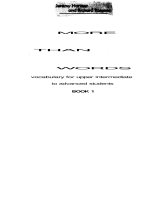Learning Express visual Writing PHẦN 1 ppsx
Bạn đang xem bản rút gọn của tài liệu. Xem và tải ngay bản đầy đủ của tài liệu tại đây (127.73 KB, 13 trang )
visual writing
visual
writing
Anne Hanson
®
NEW YORK
Copyright © 2002 LearningExpress, LLC.
All rights reserved under International and Pan-American Copyright
Conventions. Published in the United States by LearningExpress, LLC, New
Yo r k .
Printed in the United States of America
Library of Congress Cataloging-in-Publication Data:
Hanson, Anne, 1950-
Visual writing / by Anne Hanson—1st ed.
p.cm
ISBN 1-57685-405-1
1. English language—Rhetoric. 2. Visual communications.
3. Visual perception. 4. Report writing. I. Title.
PE1408 .H3295 2002
808’.042—dc21
2001038798
9 8 7 6 5 4 3 2 1
First Edition
ISBN 1-57685-405-1
For more information or to place an order, contact LearningExpress at:
900 Broadway
Suite 604
New York, NY 10003
Or visit us at:
www.learnatest.com
contents
➧ one
Organization: It’s Everywhere! 1
➧ two
Graphic Organizers: The Writer’s Widgets 9
➧ three
Visual Writing and Cereal 19
➧ four
1-2-3 Maps: Using Visual Maps to Write Essays 41
➧ five
The Good, the Bad, and the Ugly: Winning and Losing Essays 67
➧ six
Reading and Writing Practice Challenges 85
routinely seek out patterns of organization.
the brain’s quest to organize
saves three astronauts
ONE OF our brain’s prime directives,
apart from keeping us alive, is to
seek meaning out of chaos. This
instinctive desire and ability to
put things into order is one of
humanity’s greatest skills. A
scene from the movie Apollo
13 drives the point home.
A flip of a switch yields
a spark that triggers a
small explosion aboard
the Apollo 13 capsule,
aborting a trip to the
moon for three astro-
nauts. But that’s not
their only problem. They
will soon suffocate from the carbon dioxide their bodies are exhaling. Three
astronauts will perish in space unless a solution to their problem is found, fast.
It is at this point that organization saves the day.
A NASA engineer throws ordinary gadgets
and widgets onto a conference table around
which his NASA colleagues stand. The engi-
neer announces that the pile of what looks like
random pieces of junk represents all that the
Apollo 13 astronauts have at their disposal on
their spacecraft.
Will they be able to build a carbon dioxide
filter from this junk? Will they survive? This is
the dialogue in the conference room.
visual writing
2
. . . the pile of what looks
like random pieces of junk
represents all that the Apollo
13 astronauts have at their
disposal on their spacecraft.
Will they survive?
NASA CHIEF ENGINEER:
Okay, people, listen up.The people upstairs handed us this one and we gotta come
through.We gotta find a way to make this [a box] fit into the hole for this (a
cylinder) using nothing but that, [the gadgets and widgets he’s thrown onto
the table.]
ENGINEER
1
: Let’s get it organized.
ENGINEER
2
: Okay, okay: let’s build a filter.
Immediately realizing they must get it organized, they work against the
clock to save the three astronauts trapped in a soon-to-be metal gas chamber.
After examining and organizing the pile of gadgets and widgets, these skilled
engineers ultimately craft a breathing apparatus—a filter, as brilliant as it is
crude. The rest of the story is literally history and one of the twentieth cen-
tury’s greatest examples of successful problem solving. How did these engi-
neers do it?
“how to construct a makeshift filter for stranded astronauts”
Do any of us believe that any NASA engineers, who accomplished this for-
midable task, studied such a topic in any engineering textbook? Of course
not! They succeeded because they brainstormed. They successfully analyzed
their:
■ subject—saving astronauts
■ topic or objective—building a filter that functions as a breathing mechanism
■ supporting details—using available gadgets and widgets to get the job
done
They successfully searched for order and pattern amid clutter and chaos and
ultimately synthesized a unique filter that served as the breathing apparatus
that saved three lives.
organization
3
1. The box begins the objective.
2. The middle—the hose—connects the beginning to the end of the
objective with supporting details that you organize with graphic
organizers.
3. The cylinder, once connected, completes the objective.
visual writing
4
conclusion
(cylinder)
supporting details
(tubing)
1
objective
(filterbox)
3
2
did you know?
Whoever first coined the term
brainstorm
was a genius who knew what he or she was
talking about. Scientific brain imaging processes such as MRIs reveal the brain’s elec-
tronic and chemical thinking processes as different colors. They show that writers who
analyze and organize subjects and topics, using word lists and other graphic organiz-
ers before writing paragraphs, connect more neural pathways and access more
knowledge. During brain-image testing, their writing processes register as energetic
bursts of color. There really is a storm brewing in our brains.
Let the fireworks begin!
how to write an essay
for just about anyone who asks
C
ONSIDER YOURSELF an astronaut. Not just any astronaut—but an astronaut
lost in space—much like the Apollo 13 astronauts. You will potentially suffo-
cate in the capsule chamber of high stakes—timed essay tests—that are alien to
a writing process that should allow the luxury of time. If it seems like your
chamber is getting crammed with
more and more demands to write
essays, you are not imagining
things. Today’s teachers not only
test the writing skills they teach,
but they prepare you for the chal-
lenge you are sure to face, if not
now, then soon. The state and
national standardized essay tests
that are part of every student’s
career assure state and national
officials that their education tax
dollars are producing competent young writers.
Though it may sound gloomy, there is an upside to all this testing. No
matter the origin of essay tests, their topics, or audiences, the more you write
organization
5
Visual Writing helps weak writers become bet-
ter writers and strong writers become even
stronger, because it teaches them to harness
the power of visual maps, the graphic organ-
izers that lead to effective communication.
Building stronger communication skills now
will set you apart from your peers when you
enter the job market.
and learn how to write, the better
you become at writing.
visual writing
6









